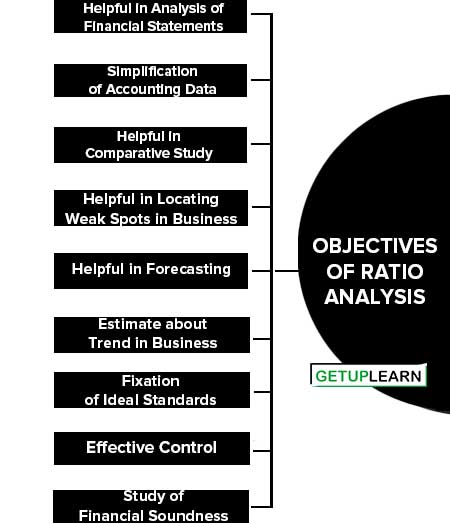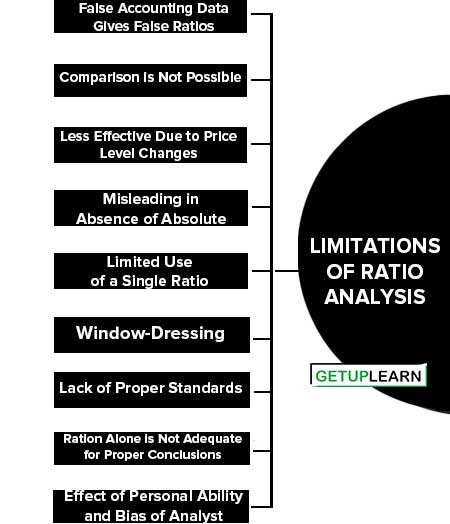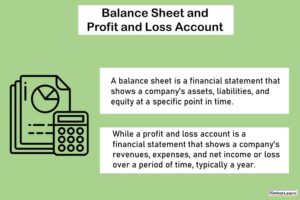Table of Contents
-
1 Objectives of Ratio Analysis
- 1.1 Helpful in Analysis of Financial Statements
- 1.2 Simplification of Accounting Data
- 1.3 Helpful in Comparative Study
- 1.4 Helpful in Locating Weak Spots in Business
- 1.5 Helpful in Forecasting
- 1.6 Estimate about Trend in Business
- 1.7 Fixation of Ideal Standards
- 1.8 Effective Control
- 1.9 Study of Financial Soundness
-
2 Limitations of Ratio Analysis
- 2.1 False Accounting Data Gives False Ratios
- 2.2 Comparison is Not Possible
- 2.3 Less Effective Due to Price Level Changes
- 2.4 Misleading in the Absence of Absolute Data
- 2.5 Limited Use of a Single Ratio
- 2.6 Window-Dressing
- 2.7 Lack of Proper Standards
- 2.8 Ration Alone is Not Adequate for Proper Conclusions
- 2.9 Effect of Personal Ability and Bias of Analyst
- 3 FAQs about the Objectives of Ratio Analysis
Objectives of Ratio Analysis
Ratio analysis is a quantitative method of gaining insights into a company’s liquidity, operational efficiency, profitability, and solvency.
This method involves comparing different items for a company’s financial statements, such as the balance sheet, income statement, and cash flow statement. It helps investors, analysts, and the company’s management make better financial decisions. The objectives of ratio analysis are discussed below:
- Helpful in Analysis of Financial Statements
- Simplification of Accounting Data
- Helpful in Comparative Study
- Helpful in Locating Weak Spots in Business
- Helpful in Forecasting
- Estimate about Trend in Business
- Fixation of Ideal Standards
- Effective Control
- Study of Financial Soundness

Helpful in Analysis of Financial Statements
Ratio analysis is an extremely useful device for analyzing financial statements. It helps bankers, creditors, investors, shareholders, etc. in acquiring enough knowledge about the profitability and financial health of the business.
Simplification of Accounting Data
Accounting ratio simplifies and summarizes a long array of accounting data and makes them understandable. It discloses the relationship between two such figures which have a cause-and-effect relationship with each other.
Helpful in Comparative Study
With the help of ratio analysis comparison of profitability and financial soundness can be made between one firm and another in the same industry. Similarly, a comparison of current year figures can also be made with those of previous years with the help of ratio analysis.
Helpful in Locating Weak Spots in Business
Current year’s ratios are compared with those of the previous years and if some weak spots are located, remedial measures are taken to correct them.
Helpful in Forecasting
Accounting ratios are very helpful in forecasting and preparing plans for the future. For example, if sales of a firm during this year are Rs. 10 Lakhs and the average amount of stock kept during the year was Rs. 2 Lakhs, i.e., 20% of sales and if the firm wishes to increase sales in the next year to Rs.15 Lakhs, it must be ready to keep a stock of Rs.3, 00,000, i.e., 20% of 15 Lakhs.
Estimate about Trend in Business
If accounting ratios are prepared for a number of years, they will reveal the trend of costs, sales, profits, and other important facts.
Fixation of Ideal Standards
Ratios help us in establishing ideal standards for the different items of the business. By comparing the actual ratios calculated at the end of the year with the ideal ratios, the efficiency of the business can be easily measured.
Effective Control
Ratio analysis discloses the liquidity, solvency, and profitability of the business enterprise. Such information enables management to assess the changes that have taken place over a period of time in the financial activities of the business. It helps them in discharging their managerial functions, e.g., planning, organizing, directing, communicating, and controlling more effectively.
Study of Financial Soundness
Ratio analysis discloses the position of business with different view’-points. It discloses the position of the business from the liquidity point of view, solvency point of view, profitability point of view, etc. With the help of such a study, we can draw conclusions regarding the financial health of the business enterprise.
Limitations of Ratio Analysis
These are the limitations of ratio analysis explained below:
- False Accounting Data Gives False Ratios
- Comparison is Not Possible
- Less Effective Due to Price Level Changes
- Misleading in the Absence of Absolute Data
- Limited Use of a Single Ratio
- Window-Dressing
- Lack of Proper Standards
- Ration Alone is Not Adequate for Proper Conclusions
- Effect of Personal Ability and Bias of Analyst

False Accounting Data Gives False Ratios
Accounting ratios are calculated on the basis of data given in the profit and loss accounts and balance sheets. Therefore, they will be only as correct as the accounting data on which they are based. For ‘example, if the -closing stock is overvalued, not only the profitability will be overstated but also the financial position will appear to be better.
Comparison is Not Possible
Comparison is not possible if the different Firms Adopt Different Accounting Policies: There may be different accounting policies adopted by different firms with regard to providing depreciation, creation of provision for doubtful debts, method of valuation of closing stock, etc.
Less Effective Due to Price Level Changes
Ratio Analysis Becomes Less Effective Due to Price Level Changes: Price’ level over the years goes on changing; therefore, the ratios of various years cannot be compared. For example, one firm sells 1,000 Machines for Rs. 10 Lakhs in dunng2002, it again sells 1,500 Machines of the same type in 2003 but owing to rising prices the sale price was Rs. 15 Lakhs.
On the basis of ratios, it will be concluded that the sales have increased by 50%, whereas in actuality,-sales have not increased at all. Hence, the figures for the past years must be adjusted in light of price level changes before the ratios for these years are compared.
Misleading in the Absence of Absolute Data
Ratios may be Misleading in the Absence of Absolute Data: For example, X company produces 10 lakh meters of cloth in 2002 and 15 Lakh meters in 2003, the progress is 50%. Y Company raises its production from 10 thousand meters in 2002 to 20 thousand meters in 2003, the progress is 100%.
A comparison of these two firms made on the basis of ratio will disclose that the second firm is more active than the first firm. Such a conclusion is quite misleading because of the difference in the size of the two firms. It is, therefore, essential to study the ratios along with the absolute data on which they are based.
Limited Use of a Single Ratio
The analyst should not merely rely on a single ratio. He should study several connected ratios before reaching a conclusion. For example, the Current Ratio of a firm may be quite satisfactory, whereas the Quick Ratio may be unsatisfactory.
Window-Dressing
Some companies in order to cover up their bad financial position resort to window dressing, i.e., showing a better position than the one which really exists.
Lack of Proper Standards
Circumstances differ from firm to firm hence no standard ratio can be fixed for all the firms. For ex if a firm has such type of relations with its bankers that it can get necessary credit in case of need, the ideal current ratio for the firm would be less than the generally accepted current ideal ratio of 2:1.
Ration Alone is Not Adequate for Proper Conclusions
They merely indicate the probability of a favorable or unfavorable position. The analyst has to use other tools and techniques to further carry out the investigation and arrive at a correct diagnosis.
Effect of Personal Ability and Bias of Analyst
Different people draw different meanings of different terms. For example, one analyst may calculate a ratio on the basis of profit after interest and tax while another may consider profits before interest and Tax.
FAQs about the Objectives of Ratio Analysis
What are the objectives of ratio analysis?
The objectives of ratio analysis are:
1. Helpful in the Analysis of Financial Statements
2. Simplification of Accounting Data
3. Helpful in Comparative Study
4. Helpful in Locating Weak Spots in Business
5. Helpful in Forecasting
6. Estimate about Trend in Business
7. Fixation of Ideal Standards
8. Effective Control
9. Study of Financial Soundness.
What are the limitations of ratio analysis?
The limitations of ratio analysis are:
1. False Accounting Data Gives False Ratios
2. Comparison is Not Possible
3. Less Effective Due to Price Level Changes
4. Misleading in the Absence of Absolute Data
5. Limited Use of a Single Ratio
6. Window-Dressing
7. Lack of Proper Standards
8. Ration Alone is Not Adequate for Proper Conclusions
9. Effect of Personal Ability and Bias of Analyst.

